Last updated: October 25, 2024
Article
Connections to Korea: The "Forgotten War" in the Eisenhower Home
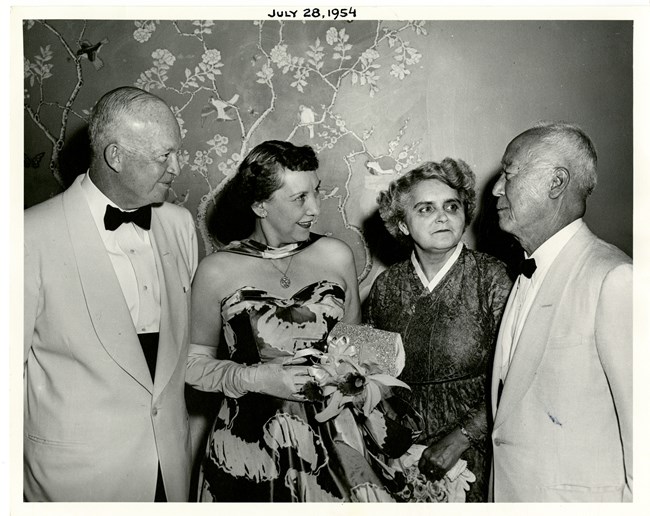
Dwight D. Eisenhower Presidential Library
Though often considered a forgotten war, the Korean War had an impact of global proportions. The realities of the conflict touched and shaped the lives of millions, and called many a man and woman to act, including Dwight D. Eisenhower. Even though he and Mamie had just purchased their Gettysburg fixer-upper in 1950 (becoming first-time homeowners), any plans for retirement were put on hold as public service continued to call on them. As the first commander of NATO, a distinguished Five-Star general, and a career soldier, Eisenhower was no stranger to the realities of war on a world stage. His extraordinary military career, which from an early age shaped his leadership skills and strategies, is part of what made him such an ideal candidate for the Presidential election of 1952.
The Korean War and the ever intensifying Cold War remained at the center of global conversations, and campaign discussions, throughout the 1952 election season. During an October campaign stop in Detroit, Michigan, Dwight Eisenhower made a promise to the American people in regard to the ongoing Korean War, which had already affected millions of Americans and Allies alike. In reference to the job of the man who, upon election as president would inherit the global conflict, he said;
“That job requires a personal trip to Korea. I shall make that trip. Only in that way could I learn how best to serve the American people in the cause of peace. I shall go to Korea.”
It was a promise made, and after Eisenhower was elected, it was a promise kept. President-elect Eisenhower’s December 1952 journey to Korea was one of great personal and political relevance. Aside from his former role as a General, and his future role as a President, Eisenhower maintained a life-time role as a father. Like other American families, his son was deployed to the frontlines of this bloody stalemate. The war shaped his relationship with his son, and his relationship with the rest of the world. It also shaped his first term as President, when an armistice agreement was signed in July of 1953.
It’s no surprise then that such a monumental facet of the Eisenhower administration is preserved in the Eisenhower home. Our collection, which spans over 50,000 objects, paints a picture of the lives Dwight and Mamie Eisenhower led. Each and every object, unsurprisingly, connects to a unique piece of their story, their journey, and their identity as globally admired leaders, who doubled as grandparents. Ranging from dinner plates to farm equipment and fur-lined winter boots, the objects they used, wore, displayed (or didn’t display) help us understand who the Eisenhowers were, and what their life experiences meant.
Within the collection of Eisenhower National Historic Site, are a number of objects that reflect the role the Korean War and eventual Armistice played in Eisenhower’s presidency, policy and personal life. Some are more prominently on display, while others take a bit of sleuthing to discover.
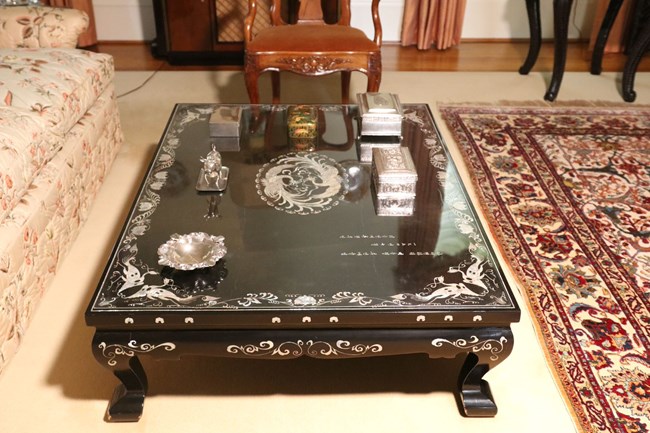
NPS Photo
Korean Coffee Table
This table, located in the living room of the home, is one of the many gifts to the Eisenhowers on display at Eisenhower NHS. There is very little Asian art or imagery throughout the Eisenhower home, but this coffee table takes a prominent place in a room where guests were received and family holidays were celebrated. It’s of mid-20th century style, with short cabriole legs that end in square, block feet. The table is inlaid with Korean abalone shell, and though referred to as a coffee table, it probably wasn’t used to set down drinks of any kind!
The rectangular top is inlaid with a continuous border of mythical birds, and trailing vines and blossoms. In the center, an oval design houses two larger birds that closely resemble Korean phoenix. Many nations across Asia have a connection to these mythological birds, which have sometimes been known to symbolize rebirth, immortality, honesty and luck. Today, the symbol of the double phoenix is still widely used and can be found depicted on Korean coins, in ancient artworks, and on the seal of the President of the Republic of Korea.
A small inscription in the corner of the tabletop notes its recipient, First Lady Mamie Eisenhower and its gifter, First Lady Francesca Donner Rhee, wife of the President of the Republic of Korea, as well as the date of the gifting; July 1954.
President Syngman Rhee and First Lady Francesca Donner Rhee visited the Eisenhowers in Washington in July of 1954. Their visit fell over the first anniversary of the Korean Armistice Agreement, which was, and remains the longest negotiated armistice in history. It is highly likely that during this state visit, the table was gifted to Mamie Eisenhower.
Mamie and Francesca were both dutiful First Ladies in their own right, often photographed at their husband’s side and supportive of their careers, the women came from very different backgrounds, and experienced different popularity and admiration amongst their people. Both however, were known for their frugality- and of course, must be credited for their exceptional taste in gifts.
This unique gift connects two First Ladies, who though living worlds apart from one another, were united by a common cause and conflict.
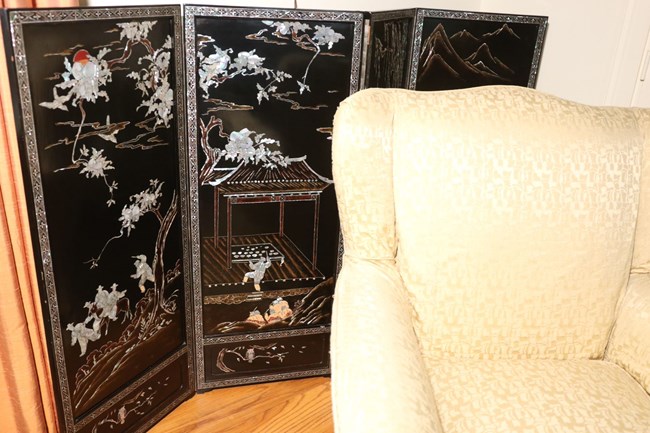
NPS Photo
Folding Screen
Similar in style and origin to the coffee table, the presentation folding screen in the living room also indicates a connection to the "Forgotten War".
This screen is located directly below the portrait of Mamie’s mother, Mrs. Elivera Doud, to the left of the fireplace. Each panel depicts scenes in flowering, mountain and pavilion landscapes, and includes figures with horses, and owls roosted on tree branches. The panels are bordered with an ornate geometric design.
Also a gift to the Eisenhowers, the screen was from His Excellency and Madame Sohn Won-Yil, Minister of National Defense, Republic of Korea. It was also gifted in 1954, though later in the year than the coffee table.
The curator at Eisenhower National Historic Site knew where to reinstall the screen in the home based on a 1980 oral history interview with Delores Moaney, who was employed by the Eisenhowers and lived in the home with them for a number of years, with her husband John Moaney, their valet. John Moaney himself was a soldier, drafted at the age of 27 in 1941. It was during the Second World War that he began serving on General Eisenhower’s staff, thus beginning a 30-year relationship that followed them from a war zone to the White House, and of course, to the Gettysburg Farm. With an intimate knowledge of the home and its contents, the Moaneys were an invaluable source in piecing together daily life in Gettysburg.
In her 1980 interview, Delores recalled a void in the northeast corner of the living room, remembering a black and gold “cabinet or screen.” The presentation screen remains on display in the living room today, not far from the coffee table it compliments.
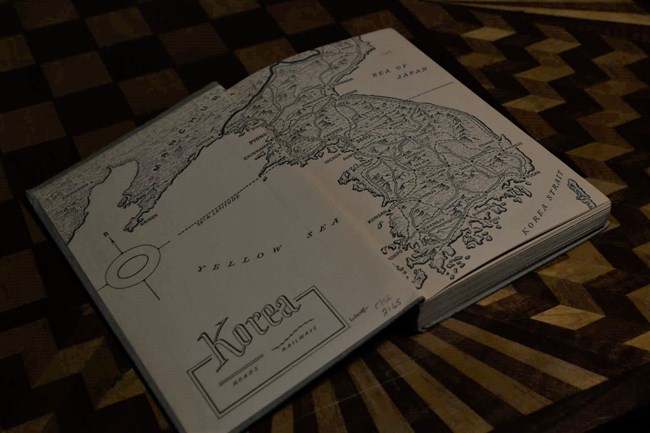
NPS Photo
War in Korea: The Report of a Woman Combat Correspondent by Marguerite Higgins
There are over nine hundred books on display in the Eisenhower home- yes, Ike and Mamie were both readers! (A full listing of the books on display can be found here). Nearly four hundred more are kept in an off site storage facility. Of all of the titles and topics, only two are about the Korean War.
In the den of the home, among hundreds of titles is War in Korea: The Report of a Woman Combat Correspondent. Marguerite Higgins, once referred to as “foolishly brave,” was one of six war correspondents who were awarded the Pulitzer Prize for International Reporting in 1951 for their coverage of the outbreak of the Korean War. The difference between Higgins and her co-recipients? She was a woman.
The Pulitzer jury wrote in their report that Higgins showed “fine front line reporting showing enterprise and courage,” adding: “She is entitled to special consideration by reason of being a woman, since she had to work under unusual dangers.” She became the first woman to ever receive the Pulitzer Prize for international reporting.
Although many considered war zones unfit for women, Higgins was no stranger to wartime conditions and realities. In 1945 she was among the first of the American press to enter the gates of Dachau, right alongside soldiers liberating the concentration camps. She was one of the very first reporters to arrive in Korea as word of war broke out. While there, she covered some of the conflict’s most critical engagements, such as the U.S. Marine landing at Inchon in September of 1950. Her front-line reports were engaging and detailed, and helped Americans at home humanize the fight a world away.
This book, which was published in 1951, was a bestseller.
Her international reporting eventually took Higgins to all corners of the world, where she had opportunities to interview world leaders like Nikita Khrushchev, and Jawaharlal Nehru, both of whom were guests of the Eisenhowers at their Gettysburg farm.
Higgins continued to report in times of crisis during the Vietnam War. Sadly, the young reporter contracted a tropical disease that she never fully recovered from. She died at just 45 years old at Walter Reed Army Medical Center in 1966 and is buried in Arlington National Cemetery with her husband, Lieutenant General William Evens Hall.
Higgins’s lifetime was certainly one of groundbreaking service, so it is fitting that her work is among the collection at Eisenhower National Historic Site, and remains upon the shelves, where Ike himself might have tucked it away after a thorough read.
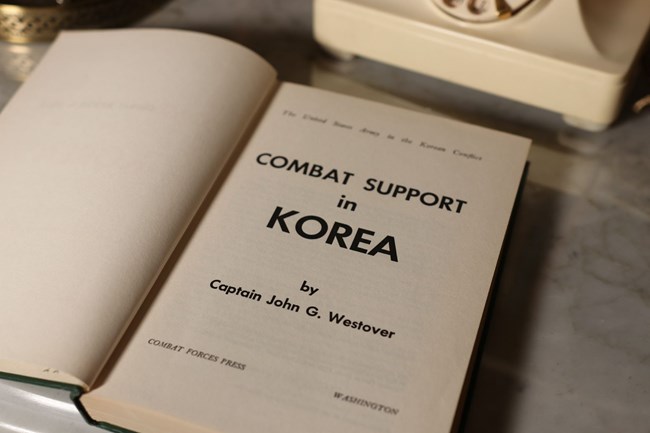
NPS Photo
Combat Support in Korea: The United States Army in the Korean Conflict by Captain John G. Westover
In the sitting room of the Eisenhower home is the second book in our collection related to the Korean War.
Combat Support in Korea, written by Captain John Westover is an analytic approach to military operations and supports throughout the war. The publication was intended to “ensure the retention and dissemination of useful information,” and while not intended to be doctrine or policy, does cite examples of how problem solving, common sense and improvision were used to solve problems in the field.
Captain Westover spent extensive time in combat during World War II serving as a combat artillerist with the 34rd Infantry Division for twenty-eight months, before spending sixteen more months as a historian in the European Theater of Operations.
Westover conducted over 140 oral history interviews with soldiers who fought in Korea to create this work. His use of oral history gave those who didn’t participate in the conflict an opportunity to understand the experience of those who did through first hand accounts, experiences, and stories. Oral history, or the collecting of personal thoughts, memoirs, and events through interview-like conversations, was increasingly used and expanded upon by the United States Military during the Second World War. Army historians ramped up their use of the technique to capture experiences of men and women of different rank, background and service.
Documenting these experiences and records became an invaluable way to recount and analyze accurate information about combat operations. Westover, who had extensive experience as an army historian, implemented these techniques in Korea as well. Though he stepped back from military service following the Second World War to pursue a PhD at the University of Missouri and join the teaching faculty at Arizona State College, he returned to active duty at the outbreak of the war in 1951.
His publication, which focuses on small-unit operations, is not, as he states in the introduction, intended to produce a succinct history of the war. Instead the text should “widen the novice leader's experience before he goes into the field.....supply illustrations for instructors, and they refresh officers who have not recently been in the field......present vividly the problems of the other services with which we are not acquainted.”
His method of compiling and analyzing oral history interviews is still widely used and highly regarded today. Oral histories capture stories and experiences that numbers and statistics alone cannot. Historical Societies, educational institutions, and even National Parks like Eisenhower National Historic Site utilize oral histories and oral history projects to piece together the stories that we share.
- Duration:
- 5 minutes, 5 seconds
The Korean War Armistice was one of Eisenhower's proudest achievements during his presidency. Join Park Ranger Eva Blankenhorn for an in depth look at the armistice and an item in the Eisenhower home that represents it--an ornate Korean table, gifted to First Lady Mamie Eisenhower by Mrs. Francesca Rhee, the First Lady of South Korea.
Tags
- dwight d. eisenhower memorial
- eisenhower national historic site
- korean war veterans memorial
- korean war memorial
- korean war
- eisenhower family
- john eisenhower
- president eisenhower
- museum collections
- eisenhower national historic site
- dwight d. eisenhower memorial
- dwight d. eisenhower
- korea
- historic homes
